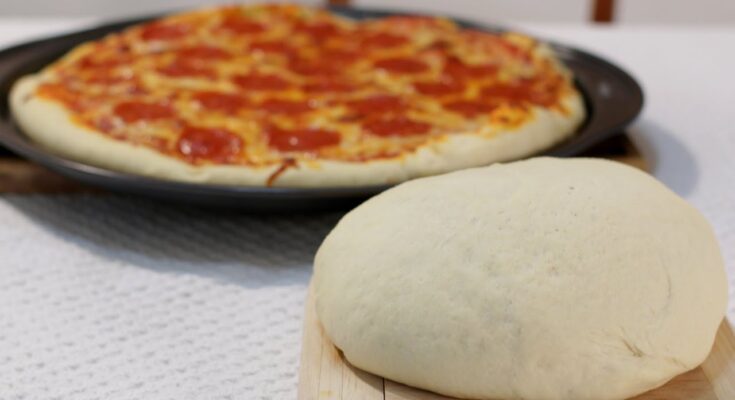Pizza Dough Recipe: If you’re a pizza lover, you know the secret to a great pizza is in the dough. While store-bought pizza crusts can be convenient, nothing beats the taste and texture of homemade pizza dough.
Whether you’re aiming for a crispy thin crust or a chewy, airy base, mastering pizza dough is the first step towards perfecting your homemade pizza game.
Ingredients for Pizza Dough
Before diving into the recipe, let’s first go over the essentials:
Essential Ingredients:
- Flour: All-purpose flour works great for pizza dough, but bread flour will give your dough more chewiness.
- Yeast: Yeast is what helps your dough rise and gives it that perfect airy texture.
- Water: Lukewarm water is crucial for activating yeast.
- Salt: Enhances the flavor of your dough.
- Olive Oil: Adds a rich, smooth texture and prevents the dough from sticking.
Optional Ingredients for Extra Flavor:
- Honey or Sugar: A bit of sugar or honey can help activate the yeast faster and adds a subtle sweetness.
- Garlic Powder or Italian Herbs: Infuse your dough with extra flavor by adding a teaspoon of garlic powder or dried herbs.
Equipment Needed
Making pizza dough is easier with the right tools. Here’s what you’ll need:
- A large mixing bowl
- A wooden spoon or dough scraper
- A kitchen scale (for measuring flour accurately)
- A stand mixer with a dough hook (optional)
- Clean kitchen towels for covering the dough
- A pizza stone or baking sheet for baking
Understanding Yeast in Pizza Dough
Yeast is the magic ingredient that makes pizza dough rise, resulting in a light and fluffy texture. There are two common types of yeast you can use:
Types of Yeast:
- Active Dry Yeast: This needs to be dissolved in water before mixing with other ingredients.
- Instant Yeast: Can be mixed directly with the flour and doesn’t need to be dissolved.
Step-by-Step Pizza Dough Recipe
Now that you’ve gathered all your ingredients and equipment, let’s walk through the process.
Step 1: Mixing the Ingredients
In a large bowl, combine 2 ½ cups of flour, 1 teaspoon of salt, and 2 teaspoons of instant yeast. Slowly add 1 cup of lukewarm water and 2 tablespoons of olive oil. Stir the mixture until it forms a shaggy dough.
Step 2: Kneading the Dough
Turn the dough out onto a floured surface and knead for about 8-10 minutes until smooth and elastic. If the dough is too sticky, add a little more flour, a tablespoon at a time. If you’re using a stand mixer, knead the dough on medium speed for about 6 minutes.
Step 3: First Rise
Place your dough in a lightly oiled bowl, cover it with a damp kitchen towel, and let it rise for 1 to 1 ½ hours, or until it has doubled in size. This allows the yeast to ferment, creating air bubbles in the dough.
Step 4: Punching Down and Second Rise
Once the dough has doubled in size, punch it down to release the gas. You can either shape the dough now or let it rise a second time for another 30 minutes to develop more flavor.
Step 5: Shaping the Dough
Turn the dough out onto a floured surface and gently stretch it into your desired pizza shape. Aim for a thickness of around ¼ inch for a standard crust.
Kneading Techniques
If kneading by hand, use the “push-fold-turn” method to properly work the dough. Stand mixers save time and effort but be careful not to over-knead the dough—it should be smooth, not sticky.
The Importance of Dough Fermentation
Letting the dough rise is crucial because it allows the gluten to relax, resulting in a softer, more flavorful crust. Typically, the dough should rise for about 1 to 1 ½ hours, but this can vary depending on your kitchen’s temperature.
Cold Fermentation for Better Flavor
If you’re not in a rush, try cold fermenting your pizza dough. Simply store the dough in the fridge for 24-72 hours after the first rise. This slows down the yeast activity, resulting in a richer, more complex flavor.
Troubleshooting Pizza Dough
Sometimes things can go wrong. If your dough is:
- Too Sticky: Add a small amount of flour and knead it in.
- Too Dry: Add a bit of water and knead again.
- Not Rising: Ensure your yeast is fresh and the water was the right temperature. Cold water or old yeast can prevent rising.
How to Store Pizza Dough
You can refrigerate dough for up to 3 days. If freezing, divide the dough into portions, wrap them in plastic wrap, and freeze for up to 3 months. Let it thaw in the fridge overnight before using.
Tips for Shaping the Perfect Pizza
When shaping, avoid using a rolling pin as it can knock out the air bubbles. Instead, stretch the dough by hand, gently working it outwards from the center. For an even crust, rotate the dough as you stretch it.
Baking Your Pizza Dough
Preheat your oven to 475°F (245°C) at least 30 minutes before baking. If you have a pizza stone, place it in the oven while preheating. Bake the pizza for 10-15 minutes or until the crust is golden and crispy.
Topping Suggestions
Classic toppings include mozzarella, tomato sauce, pepperoni, and fresh basil. For something different, try toppings like goat cheese, figs, arugula, or spicy sausage.
Serving Suggestions
Serve your pizza with a simple green salad or garlic bread on the side. For beverages, wine, craft beer, or soda pair wonderfully with pizza.
FAQs about Pizza Dough Recipe
1. Can I use all-purpose flour for pizza dough?
Yes, all-purpose flour works well for pizza dough. It creates a softer, chewier crust compared to bread flour, which gives a crispier texture.
2. How long does it take to make pizza dough?
It usually takes about 10–15 minutes to prepare the dough, but you’ll need 1–2 hours for it to rise, depending on the temperature.
3. Can I freeze pizza dough?
Yes, pizza dough can be frozen. After the dough has risen, divide it into portions, wrap each piece in plastic, and store in an airtight container for up to 3 months.
4. Do I need to let the dough rest before baking?
Yes, allowing the dough to rest for 10–15 minutes after shaping helps relax the gluten, making it easier to stretch and ensuring a better texture when baked.
5. How thin should I roll my pizza dough?
This depends on your preference. For a thin crust, roll it out to about 1/8 inch. If you prefer a thicker crust, aim for about 1/4 inch.
Conclusion
In conclusion, a pizza dough recipe offers the perfect balance of simplicity and versatility, making it an excellent choice for dessert. Whether you prefer a classic cinnamon sugar twist or want to explore creative toppings, the possibilities are endless. The dough’s light, chewy texture combined with sweet flavors creates a satisfying treat that can be customized to your liking.
Why not give this recipe a try? With just a few ingredients and minimal prep, you can enjoy a delightful dessert that’s sure to impress your taste buds and your guests!



